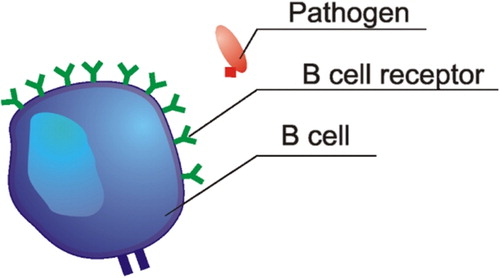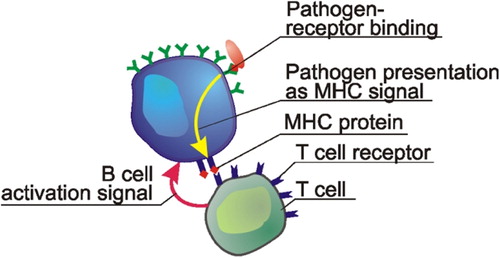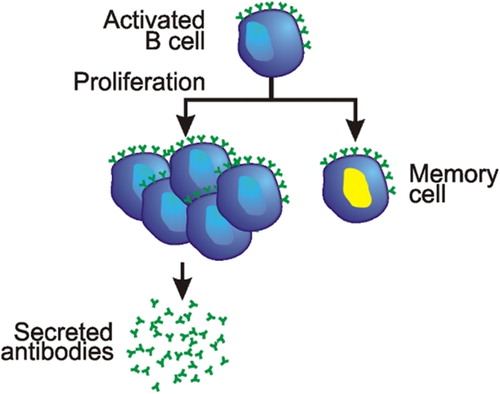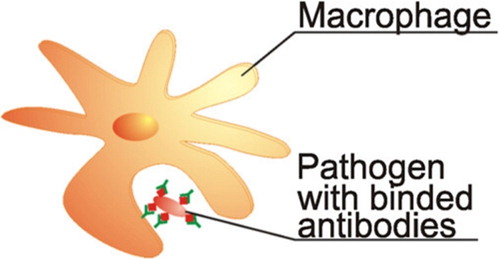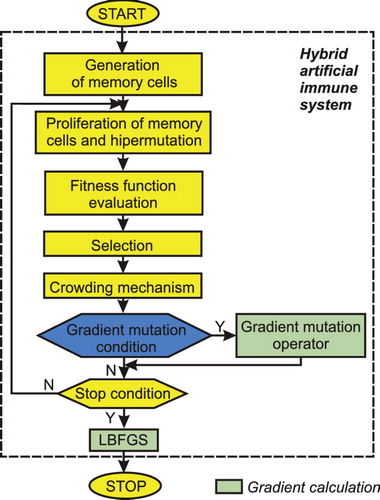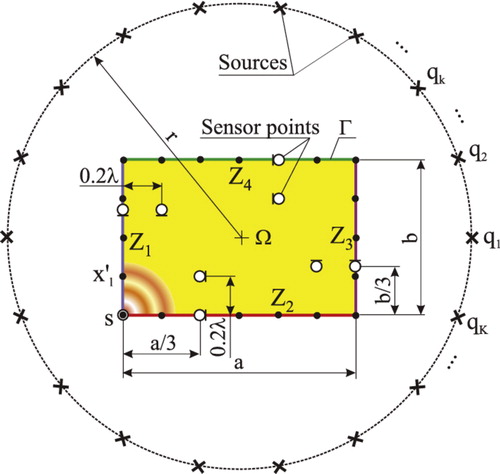Abstract
The paper deals with an application of a hybrid artificial immune system (HAIS) to the identification problems. The HAIS is applied to identify complex impedances of room walls. This approach is based on the mechanism discovered in biological immune systems. The numerical example demonstrates that the method based on immune computation is an effective technique for solving computer aided in identification problem.
1. Introduction
Identification of parameters in physical systems using the artificial intelligence techniques is a very active field of research.Citation[1,2,3,4,5,6,7] The main approach in solving the identification problem is to find the parameters of physical systems using the response of the structure. Several novel techniques have been recently developed.
One of the best known-approaches is based on the minimization of the special functional.Citation[8] In Citation[8], the identification problem consists in finding such values of the material constants, which give solution fields that differ the least from the measured ones known from the experiment. The fields on the boundary are known at a given number of boundary points. The identification problem of material constants is equivalent to the minimization problem of the special functional. Minimization with respect to the searched parameters can be done using many approaches.
A general approach is presented in Citation[9]. In this work the genetic least-squares technique is applied for system identification. In Citation[7] genetic algorithms are used for identification of material constants in anisotropic media. The evolutionary algorithm (EA) for identification of material coefficients of human pelvic bone was used in Citation[10]. In Citation[11], the authors applied the evolutionary-simplex algorithm and structural dynamic response to identify the structural physical parameters. A genetic algorithm was also applied in Citation[6] to search for the elastic parameters of composites.
In another interesting approach, the genetic or EAs are connected with other optimization techniques.Citation[3] In Citation[3], the combination of topological sensitivity and genetic algorithms are used for identification inverse problems in anisotropic materials. Also Citation[8] proposed gradient-based, genetic and hybrid optimization algorithms for material parameters identification problem. Identification of effective elastic constants of composite plates based on a hybrid genetic algorithm was also considered in Citation[4].
Another approach to inverse identification problems, based on hybrid techniques, has been developed in Citation[12], where the surrogate-model accelerated random search algorithm for global optimization was applied to inverse material identification. Recently, Zilong et al. Citation[13] proposed the immune EA incorporating chaos optimization. A evolutionary AIS was applied to multi-objective optimization in Citation[14].
In this article, new method of identification problem is proposed. This article concerns the application of the method of fundamental solutions (MFS) Citation[15] coupled with a hybrid artificial immune system (HAIS) Citation[16] in order to identify complex impedances of room walls. This method is used in other interesting approach.Citation[17] The authors also developed another global optimization method like EA.Citation[18–22] Results of identification process of complex impedances of room walls using EA and MFS are described in Citation[23].
The acoustic field control and design require the determination of structure parameters,Citation[24] e.g. the acoustic absorption of building materials. The measurements of specimens under laboratory conditions or real objects under in situ conditions can be performed. In the first method certain assumptions are introduced which do not correspond to in situ conditions. The second method leads to some difficulties, e.g. the presence of parasitic noise sources. Dutilleux et al. Citation[25] proposed another method for the determination of sound absorption in rooms. They defined a boundary inverse problem which was solved by using the evolution strategy (ES). The proposed method consisted in the minimization of cost function dependent on the difference between measured and computed acoustic pressure values. The measurements were simulated by a numerical analysis. The stationary acoustic pressure field was computed by using the finite difference method. The proposed method was successfully applied to the solution of low-frequency problems (frequencies up to 240 Hz). The method can be relatively inefficient with respect to the computation time as it requires multiple calculations of the cost function. There are two possibilities of the efficiency improvement. The first one is related to the reduction of direct problem solution time, and the second one to the optimization algorithm convergence. In order to improve the method one can apply a boundary method coupled with an improved optimization algorithm, e.g. a hybrid one. Numerical examples are given and good results are obtained.
In the authors’ opinion, no application of the HAIS for solving inverse identification problems in acoustic field modelled by using the MFS can be found in the literature until now.
This paper is organized as follows. In Section 2, the HAIS is briefly reviewed. In Section 3, the formulation problem is presented. In Section 4, the MFS is described. In Section 5, a benchmark numerical example is presented. Finally, concluding remarks are given in Section 6.
2 Hybrid artificial immune systems
The artificial immune systems (AIS) are developed on the basis of a mechanism discovered in biological immune systems.Citation[26] An immune system is a complex system which contains distributed groups of specialized cells and organs. The main purpose of the immune system is to recognize and destroy pathogens – funguses, viruses, bacteria and improper functioning cells. The lymphocytes cells play a very important role in the immune system. The lymphocytes are divided into several groups of cells. There are two main groups B and T-cells, both containing some subgroups. The B-cells contain antibodies, which could neutralize pathogens and are also used to recognize pathogens (Figure ).
There is a big diversity between antibodies of the B-cells, allowing recognition and neutralisation of many different pathogens. The B cells are produced in the bone marrow in long bones. A B-cell undergoes a mutation process to achieve big diversity of antibodies. The T-cells mature in thymus, only T-cells recognising non-self cells are released to the lymphatic and the blood systems. There are also other cells like macrophages with presenting properties; the pathogens are processed by a cell and presented by using Major Histocompatibility Complex (MHC) proteins. The recognition of a pathogen is performed in a few steps. First, the B-cells or macrophages present the pathogen to a T-cell using MHC (Figure ).
The T-cell decides if the presented antigen is a pathogen. The T-cell gives a chemical signal to B-cells to release antibodies. A part of stimulated B-cells goes to a lymph node and proliferate (clone) (Figure ).
A part of the B-cells changes into memory cells, the rest of them secrete antibodies into blood. The secondary response of the immunology system in the presence of known pathogens is faster because of memory cells. The memory cells created during primary response proliferate and the antibodies are secreted to blood (Figure ).
The antibodies bind to pathogens and neutralize them. Other cells like macrophages destroy pathogens (Figure ). The number of lymphocytes in the organism changes while the presence of pathogens increases, but after attacks a part of the lymphocytes is removed from the organism.
The AIS take only a few elements from the biological immune systems. The most frequently used are the mutation of the B-cells, proliferation, memory cells and recognition by using the B and T-cells. The presented approach is based on the Wierzchoń’s algorithm,Citation[27] but the mutation operator is changed. The Gaussian mutation is used instead of the non-uniform mutation in the presented approach. At the beginning of the AIS, the memory cells are created randomly. They proliferate and mutate creating B-cells. The number of clones created by each memory cell is determined by the memory cells objective function value. The objective functions for B-cells are evaluated. The selection process exchanges some memory cells for better B-cells. The selection is performed on the basis of the geometrical distance between each memory cell and B-cells (measured by using design variables). The crowding mechanism removes similar memory cells. The similarity is also determined as the geometrical distance between memory cells. The process is iteratively repeated until a stop condition is fulfilled. The conventional AIS is schematically shown in the paper Citation[17] and its hybridization in the Figure .
The AIS are widely used in the solution of global optimization problems. Their efficiency can be improved by the coupling with gradient methods (hybridization). In this work a HAIS is applied. This algorithm uses a gradient mutation operator and a gradient minimization method (Figure ).
The hybrid algorithm contains a few additional blocks. The first one (Gradient mutation condition) checks the equality between the best solution in the current iteration and the best solution in the previous iteration. The condition indicates whether or not the conventional AIS operators improve the solution.
If the condition is satisfied, a gradient mutation operator is applied for the best cell. It consists in a change of the cell in the direction of steepest descent of the fitness function. A series of steps are generated, forming geometrical progression, and the best one, which minimizes the cost function, is chosen.
The gradient mutation operator consists in the change of selected B-cell receptor towards the cost function gradient.Citation[16] The operator is used only if the conventional operators do not improve fitness (cost) of the best B-cell receptor (the Gradient mutation condition block in Figure ). After each iteration, a stop condition is checked, in which the ratio of gradient–mutation iterations to all iterations is compared to a number close to 1, which is a parameter of the method. When the ratio exceeds the value, it can be assumed that only the gradient operator causes the fitness (cost) improvement. The AIS is stopped then and the limited memory Broyden–Fletcher–Goldfarb–Shanno procedure (LBFGS),Citation[28] which is a gradient quasi-Newton method, is executed.
In the algorithm, two stages can be distinguished and gradient calculations are performed at both the stages. At the first stage, the immunology one, the gradient mutation operator improves the convergence of immunology process, and also indicates whether the conventional immunology operators improve the solution or not. This stage can be considered as a concurrent immunology–gradient algorithm. At the second stage, the immunology process is terminated and the gradient optimization algorithm is executed. At this stage, a rapid convergence to the global optimum is observed. Summarizing, in this work an efficient concurrent-sequential hybrid immune algorithm was proposed.
3 Problem formulation
A closed 2D cavity Ω with boundary Γ is considered. A point source of complex amplitude A is located at the point s inside the cavity. The complex acoustic pressure field p(x) satisfies the non-homogenous Helmholtz equation:(1)
where κ is the wavenumber and δ is the Dirac distribution. At the boundary of the cavity, the impedance boundary condition is imposed:(2)
where Z is an unknown complex impedance of the cavity wall (room wall), i is the imaginary unit, ω is the angular frequency, ρ is the density of an acoustic medium and n(x) is the outward unit normal to Γ. The acoustic pressure field can be evaluated at any point of the cavity by the application of a numerical method to the solution of Equation (1). The computed values pj can be compared to results of in situ measurements and thus the unknown parameters can be determined. The identification task is to find the values of Z by the minimization of the cost function:
(3)
where J is the number of sensor points. In order to solve the identification problem, the HAIS described in the previous section is applied.
4 The MFS
In the MFS, the solution of Equation (1) can be expressed as a sum of the pressure generated by the source s of amplitude A, and of a finite series corresponding to another K sources qk with unknown coefficients ck:(4)
where G is the fundamental solution of the Helmholtz equation for 2-D problems:(5)
The fundamental solution depends on which is the Hankel function of the 1st kind, order 0. By the application of the Equation (4) and the boundary condition (2), and by the substitution of x with the boundary nodes
, l = 1, 2, ..., L, one obtains the following system of equations:
(6)
which is solved for the coefficients ck. By the application of the results and Equation (4), one can evaluate the pressure field at any point of the cavity. The method is very efficient as it does not require any domain discretization nor integration. More details on the MFS can be found in the literature.Citation[15]
The solution of an optimization or identification problem may require the sensitivity analysis of the cost function with respect to design variables. In the considered problem, the sensitivity analysis can be easily performed by the direct differentiation of Equation (6) with respect to the identified parameters. The derived system of equations can be applied to the calculation of the derivatives of the coefficients ck, of the acoustic pressure field (4) and finally of the cost function (3).
5 Numerical example
Complex values of the impedances Z1–Z4 of room walls are identified. The geometry and other parameters of the analysed 2-D model of a room are presented in Figure . The same structure was considered by Dutilleux et al. Citation[25]. The dimensions of the room model are: a = 3.4 m and b = 2.5 m. The acoustic medium is air at the temperature 20 °C. The analysis is performed for the frequency equal to 100 Hz. Eight sensors are located at points with coordinates related to the wave length λ and the room dimensions. The number of both the boundary points and the sources is equal to 54. The sources are located at a circle of radius r = 2.5 m, centred at the geometric centre of the rectangle (Figure ). The identification problem, defined in Section 3, is solved by using the HAIS described in Section 2. A single B-cell receptor is defined by its parameters pm (m = 1 ÷ 8) related to real and imaginary parts of the unknown impedances, respectively:(7)
Box constrains are imposed on each B-cell as follows:(8)
The pressure measurements are simulated by the MFS analysis with the reference impedance values given in Table . A comparison between the present results and results obtained by other authors by using ES,Citation[25] is also shown.
Table 1. Reference values of genes and results obtained by using different methods.
The efficiency of proposed method is investigated and compared to the ES case presented in Citation[25]. The comparison is given in Table . The number of cost function calculations in the ES case was determined as the product of the number of iterations and the offspring population size, which equals 56. The HAIS population size is significantly less as equals only 12. In the considered case, the gradient calculation time is by an order of magnitude less in comparison with the cost function calculation time.
Table 2. Comparison of the efficiency of algorithms.
The termination condition of the LBFGS procedure has the following form Citation[28]:(9)
where p denotes the vector of design variables, which corresponds to a B-cell receptor of the AIS, and denotes the Euclidean norm. The accuracy of the optimization result is determined by the tolerance ϵ, which is set to 10−16. The procedure was executed 10 times. All results are accurate to 1 Rayl in relation to the reference values of the impedance terms.
6 Conclusions
The solution of inverse problem in room acoustics by using the MFS and the HEA was presented. The MFS does not require the domain discretization nor integration, and is convenient for sensitivity analysis. In the presented case, the additional gradient calculation procedure does not influence significantly the overall identification time, as the gradient calculation time is by an order of magnitude smaller in relation to the time of cost function calculation. The application of the gradient mutation operator and the gradient method at the final stage of the identification process by the HAIS causes both the convergence and accuracy improvements. The comparison of present results with other ones, found in literature, shows that the HAIS can be more efficient than the ES and conventional AIS with respect to the accuracy of the results and the identification time, as the number of the cost function calculations is smaller. Further problems should be analysed before more general conclusions regarding the most efficient approach could be made.
It was shown that the proposed coupling of methods provides promising results in the room impedance measurements by the solution of inverse problem. However, to confirm the practical importance of the method further investigations should be carried out, involving higher frequencies, measurement errors and 3D problems.
There are possibilities of further efficiency improvement of the proposed method, e.g. by the application of adjoint variable method in the sensitivity analysis. Also, the application of another hybridized global optimization algorithms, like particle swarm method, would be interesting. Efficiency of the proposed method can be also improved by distributing computations in multi-agent systems.Citation[29]
References
- Balthrop J, Esponda F, Forrest S, Glickman M. Coverage and generalization in an artificial immune system. In: Proceedings of the Genetic and Evolutionary Computation Conference GECCO. New York: Morgan Kaufmann; 2002. p. 3–10..
- de Castro, LN, and Timmis, J, 2003. Artificial immune iystems as a novel soft computing paradigm, Soft. Comput. 7 (2003), pp. 526–544.
- Comino, L, Gallego, R, and Rus, G, 2008. Combining topological sensitivity and genetic algorithms for identification inverse problems in anisotropic materials, Comput. Mech. 41 (2008), pp. 231–242.
- Hwang, S-F, Wu, J-C, and He, RS, 2009. Identification of effective elastic constants of composite plates based on a hybrid genetic algorithm, Compos. Struct. 90 (2009), pp. 217–224.
- Mrozek, D, and Małysiak-Mrozek, B, 2011. Improved method for protein similarity searching by alignment of fuzzy energy signatures, Int. J. Comput. Intell. Syst. 4 (2011), pp. 75–88.
- Silva, MFT, Borges, LMSA, Rochinha, FA, and de Carvalho, LAV, 2004. A genetic algorithm applied to composite elastic parameters identification, Inverse Prob. Sci. Eng. 12 (2004), pp. 17–28.
- Zieniuk, E, and Gabrel, W, 2001. Genetic algorithms based on a new system of integral equations in identification of material constants for anisotropic media, Mech. Compos. Mater. 37 (2001), pp. 217–222.
- Chaparro, BM, Thullier, S, Menezes, LF, Manach, PY, and Fernandes, JV, 2008. Material parameters identification: gradient-based, genetic and hybrid optimization, Comput. Mater. Sci. 44 (2008), pp. 339–346.
- Warwick, K, Kang, Y-H, and Mitchell, RJ, 1999. Genetic least squares for system identification, Soft. Comput. 3 (1999), pp. 200–205.
- Burczynski, T, John, A, Kuś, W, Orantek, P, and Poteralski, A, 2003. The evolutionary algorithm and hipersurface in identification of material coefficients of human pelvic bone, Acta Bioeng. Biomech. 5 (2003), pp. 61–66.
- Du, X, and Zengdi, , 2003. Structural physical parameter identification based on evolutionary-simplex algorithm and structural dynamic response, Earthquake Eng. Eng. Vib. 2 (2003), pp. 225–236.
- Brigham, JC, and Aquino, W, 2007. Surrogate-model accelerated random search algorithm for global optimization with applications to inverse material identification, Comput. Methods Appl. Mech. Eng. 196 (2007), pp. 4561–4576.
- Zilong, G, Sun’an, W, and Jian, Z, 2006. A novel immune evolutionary algorithm incorporating chaos optimization, Pattern Recogn. Lett. 27 (2006), pp. 2–8.
- Tan, KC, Goh, CK, Mamun, AA, and Ei, EZ, 2008. An evolutionary artificial immune system for multi-objective optimization, Eur. J. Oper. Res. 187 (2008), pp. 371–392.
- Fairweather, G, Karageorghis, A, and Martin, PA, 2003. The method of fundamental solutions for scattering and radiation problems, Eng. Anal. Boundary Elem. 27 (2003), pp. 759–769.
- Orantek P. The application of hybrid algorithms to the problems of optimization and identication of dynamic mechanical structures [PhD thesis]. Gliwice, Poland: Silesian University of Technology; 2002 (in Polish)..
- Poteralski A, Szczepanik M, Dziatkiewicz G, Kuś W, Burczyński T. Immune identification of piezoelectric material constants using BEM. Inverse Prob. Sci. Eng. 2011;19:103–116..
- Burczyński T, Poteralski A, Szczepanik M. Genetic generation of 2-D and 3-D structures second M.I.T. conference on computational fluid and solid mechanics. Cambridge (MA): Massachusetts Institute of Technology; 2003..
- Burczyński T, Poteralski A, Szczepanik M. Topological evolutionary computing in the optimal design of 2d and 3d structures. Eng. Optim. 2007;39:811–830..
- Burczynski T, Bereta M, Poteralski A, Szczepanik M. Immune computing: intelligent methodology and its applications in bioengineering and computational mechanics.Vol. 1, Advanced Structured Materials. Computer Methods in Mechanics. Berlin: Springer-Verlag; 2010..
- Burczynski T, Kus W, Dlugosz A, Poteralski A, Szczepanik M, Sequential and distributed evolutionary computations in structural optimization, artificial intelligence and soft computing - ICAISC 2004. Vol. 3070, Book Series: Lecture Notes in Artificial Intelligence. Berlin: Springer-Verlag; 2004. p. 1069–1074..
- Burczynski T, Dlugosz A, Kus W, Orantek P, Poteralski A, Szczepanik M. Intelligent computing in evolutionary optimal shaping of solids. In Proceedings of the 3rd International Conference on Computing, Communications and Control Technologies. Vol. 3. 2005. p. 294–298..
- Ptaszny J. Identification of room acoustic properties by the method of fundamental solutions and a hybrid evolutionary algorithm. In: Burczyński T, Periaux J, editors. Evolutionary methods for design, optimization and control. Barcelona: CIMNE; 2011 p. 122–127..
- Ciskowski RD, Brebbia CA, editors. Boundary element methods in acoustics. Southampton: Computational Mechanics Publications; 1991..
- Dutilleux, G, Sgard, FC, and Kristiansen, UR, 2002. Low-frequency assessment of the in situ acoustic absorption of materials in rooms: an inverse problem approach using evolutionary optimization, Int. J. Numer. Meth. Eng. 53 (2002), pp. 2143–2161.
- Ptak, M, and Ptak, W, 2000. Basics of immunology. Cracow: Jagiellonian University Press; 2000, (in Polish).
- Wierzchoń, ST, 2001. Artificial immune systems: theory and applications. Warsaw: EXIT Press; 2001, (in Polish).
- Liu, DC, and Nocedal, J, 1989. On the limited memory BFGS method for large-scale optimization, Math. Program. 45 (1989), pp. 503–528.
- Momot A, Małysiak-Mrozek B, Kozielski S, Mrozek D, Hera Ł, Górczyńska-Kosiorz S, Momot M, Improving performance of proteinstructure similarity searching by distributing computations inhierarchical multi-agent system. Lecture notes in artificial intelligence, LNAI 6421. Berlin: Springer-Verlag; 2010. p. 320–329..
